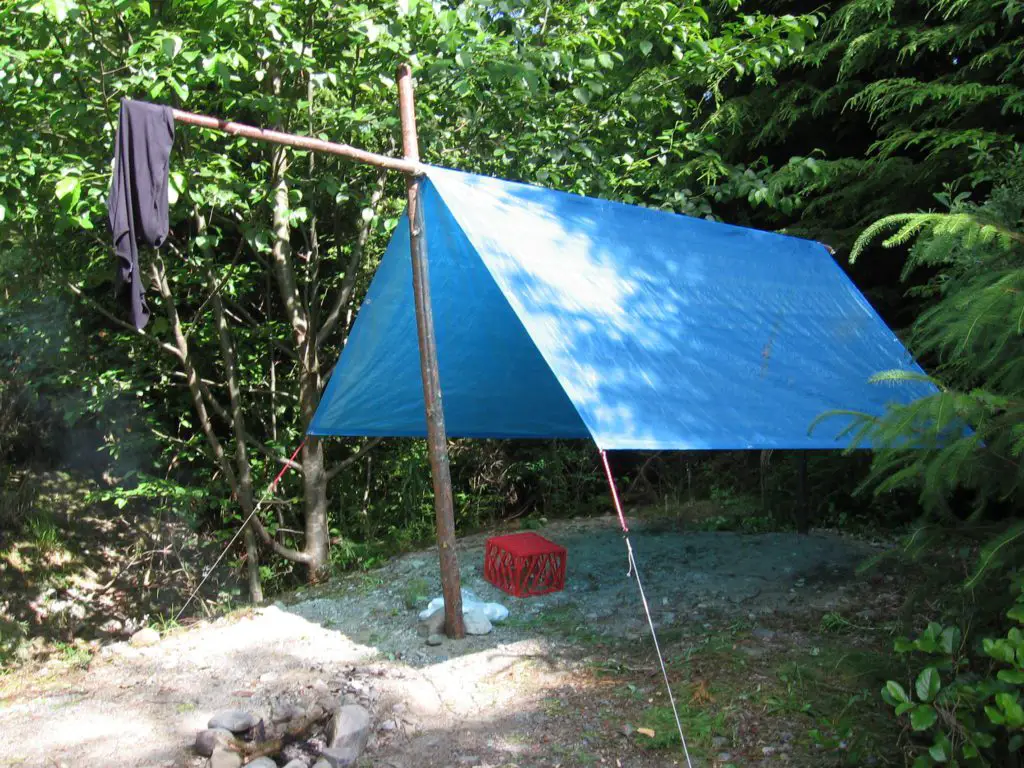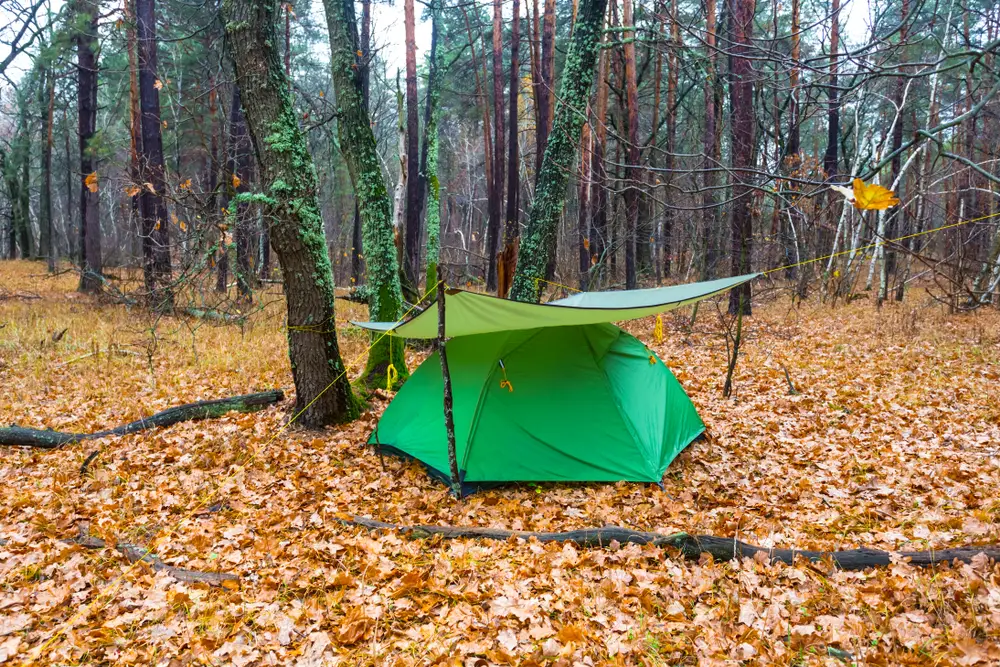I. Introduction to Tarp over Tent

A. Understanding the Benefits of Using a Tarp over Your Tent
- Exploring the Function and Importance of Tarps in Outdoor Shelter Setups Using a tarp over your tent provides an additional layer of protection and enhances the functionality of your shelter setup. Tarps act as a barrier against the elements, shielding your tent from rain, wind, and sunlight. They help to extend the lifespan of your tent and create a more comfortable camping experience.
- Enhancing the Durability and Weather Resistance of Your Tent with a Tarp By using a tarp over your tent, you can increase its durability and weather resistance. Tarps are typically made from strong and waterproof materials, providing an extra layer of protection against rain, snow, and wind. This added layer helps to prevent tears, leaks, and damage to your tent, ensuring it remains in good condition for future camping trips.
B. Finding the Right Tarp for Your Tent
- Evaluating Different Types of Tarps and Their Features for Optimal Protection When choosing a tarp for your tent, consider factors such as material, size, and features. Tarps are available in various materials, including nylon, polyester, and canvas, each with their own advantages in terms of durability and weather resistance. Additionally, consider features such as reinforced corners, grommets, and UV protection, which can enhance the functionality and longevity of the tarp.
- Choosing the Proper Size and Material to Complement Your Tent Setup Selecting the right size and material for your tarp is essential to ensure it adequately covers your tent. Consider the dimensions of your tent and choose a tarp that is slightly larger to provide sufficient coverage. Additionally, choose a material that is lightweight and easy to pack, while still offering the necessary durability and protection for your camping needs.
II. Benefits of Using a Tarp over Your Tent

A. Shielding Your Tent from Rain and Moisture
- Preventing Rainwater from Seeping into Your Tent with a Tarp Cover One of the primary benefits of using a tarp over your tent is protection from rain and moisture. A well-placed tarp acts as a rain fly, preventing water from seeping through the tent’s rainfly or seams. This helps to keep the interior of your tent dry, ensuring a comfortable and enjoyable camping experience.
- Minimizing Condensation and Keeping the Interior Dry and Comfortable Condensation can be a common issue in tents, particularly in humid or cold weather. By using a tarp over your tent, you can create an additional layer of insulation, reducing the amount of condensation that forms inside the tent. This helps to keep the interior dry, preventing dampness and maintaining a comfortable sleeping environment.
B. Protecting Against UV Rays and Sun Damage
- Creating a Barrier against Harmful UV Rays and Extending the Lifespan of Your Tent Sun exposure can cause damage to your tent’s fabric over time, leading to fading, degradation, and reduced lifespan. By using a tarp over your tent, you create a barrier against harmful UV rays, minimizing sun damage and extending the life of your tent. This is particularly important in sunny and high-altitude locations.
- Providing Shade and Keeping the Interior Cool on Sunny Days In addition to protecting against UV rays, a tarp over your tent can provide shade and help keep the interior cool on hot, sunny days. This creates a more comfortable camping experience, allowing you to escape the heat and enjoy a shaded area outside of your tent.
III. Setting Up a Tarp over Your Tent

A. Proper Tarp Placement and Attachment
- Understanding the Importance of Properly Positioning the Tarp for Maximum Coverage When setting up a tarp over your tent, it is crucial to position it correctly to maximize coverage and protection. Ensure that the tarp extends beyond the edges of your tent, providing adequate coverage for the rainfly and sides. Position the tarp to slope slightly away from the tent, allowing water to run off and prevent pooling.
- Utilizing Guy Lines, Poles, and Stakes to Secure the Tarp in Place To secure the tarp in place, use guy lines, poles, and stakes. Attach guy lines to the corners and edges of the tarp, and secure them to trees, stakes, or other sturdy objects. Use poles or additional supports to create a peak or ridge line to prevent water pooling and provide better airflow. Stakes can be used to anchor the tarp to the ground for added stability.
B. Creating a Rain Fly Configuration
- Implementing Different Tarp Configurations to Divert Water Away from Your Tent There are various tarp configurations that can be used to create a rain fly setup, diverting water away from your tent. Popular configurations include the A-frame, lean-to, or diamond shape setups.
- Ensuring Proper Water Runoff and Protection from Rainstorms When setting up a tarp over your tent, it is important to ensure proper water runoff to prevent pooling and potential leakage. Check that the tarp is taut and sloping away from your tent to allow rainwater to run off easily. Regularly check the tarp during rainstorms to ensure it is properly securing and protecting your tent from water.
IV. Tarp Maintenance and Care

A. Cleaning and Drying Your Tarp
- Proper Cleaning Techniques to Maintain the Integrity and Waterproofing of the Tarp To maintain the integrity and waterproofing of your tarp, proper cleaning techniques are essential. Use mild soap or a specialized tarp cleaner to remove dirt, debris, and stains. Gently scrub the tarp with a soft brush or sponge. Avoid using harsh chemicals or abrasive cleaners that can damage the tarp’s material or coatings.
- Ensuring the Tarp is Completely Dry before Storage to Prevent Mold and Mildew After cleaning, it is crucial to ensure that the tarp is completely dry before storing it. Allow the tarp to air dry in a well-ventilated area, preferably in direct sunlight.
B. Inspecting and Repairing Your Tarp
- Regularly Checking for Tears, Rips, and Damage to Address Potential Issues Regularly inspect your tarp for tears, rips, and other types of damage. Check the seams, corners, and any stress points where the tarp is most likely to experience wear and tear. Identifying and addressing potential issues early on can prevent further damage and extend the lifespan of your tarp.
- Applying Patch Kits or Seam Sealer to Maintain the Tarp’s Functionality If you find any tears or holes in your tarp, promptly repair them using patch kits designed for the tarp’s specific material. Follow the manufacturer’s instructions for applying patches and ensure they are securely bonded to the tarp. Seam sealer can also be used to reinforce seams and prevent water leakage. Applying seam sealer to the tarp’s seams can help maintain its functionality and waterproofing capabilities.
V. Tarp Alternatives and Considerations

A. Lightweight and Packable Tarp Options
- Exploring Lightweight and Compact Tarps Ideal for Backpacking and Minimalist Camping If you are looking for lightweight and compact options, there are tarps specifically designed for backpacking and minimalist camping. These tarps are made from lightweight materials and have a smaller footprint, making them easy to pack and carry. Consider the size, weight, and packability of the tarp to ensure it suits your outdoor adventures.
- Considering Size, Weight, and Portability Factors for Your Outdoor Adventures When choosing a tarp alternative, consider the specific size, weight, and portability factors that align with your outdoor adventures. Assess the coverage area provided by the tarp, as well as its weight and packability. Choose a tarp alternative that meets your specific needs and complements your camping or outdoor activities.
B. Other Shelter Options for Extended Protection
- Evaluating Additional Shelter Options, Such as Canopies or Gazebos, for Extended Cover In addition to tarps, other shelter options such as canopies or gazebos can provide extended protection. These options offer larger coverage areas and can provide shade and protection from the elements. Canopies and gazebos are particularly useful for outdoor events or longer camping trips where extended cover is needed.
-
Weighing the Pros and Cons of Different Shelter Choices for Your Specific Needs When considering alternative shelter options, weigh the pros and cons of each choice. Consider factors such as size, setup time, weight, and durability. Evaluate how well the shelter choice suits your specific needs, whether it’s for camping, outdoor events, or other outdoor activities. Choose a shelter option that provides the desired level of protection and meets your requirements.
Using a tarp over your tent can significantly enhance its performance and protect it from the elements. Remember to properly clean, dry, and inspect your tarp to ensure its effectiveness. Elevate your camping experience and safeguard your tent with a tarp cover for enhanced durability and weather resistance.
